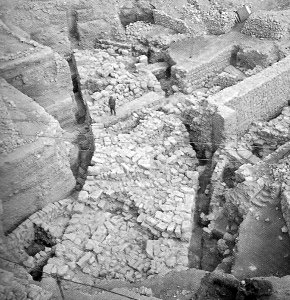
The name given by archaeologists to the wall that Hezekiah ordered to built to enclose parts of the western hills of Jerusalem in prepartion for the invasion by Assyrian forces in 722 BC.

Part of the Broad Wall in the Jewish Quarter of Jerusalem.
When the Assyrians sacked Samaria in 722 BC, thousands of refugees fled the north and settled on the north-western hills of ancient Jerusalem. These left them outside the city walls, vulnerable to any attack. As part of the defensive measures Hezekiah took in preparation for Sennacherib's onslaught he began to enclose this part of the city within a new wall. Archaeologists believe that they may have uncovered a part of this wall.
Large parts of the Jewish Quarter in Jerusalem were destroyed in the 1948 War. When Israel captured the Old City in 1967, reconstruction work begun with the clearing away of the ruins that, fortuitously, provided an opportunity for systematic excavation of the ancient city. Archaeologist Nahman Avigad uncovered a stretch of wall that can be dated, on the basis of the pottery found there, to the 8th Cent BC. Avigad believes that this wall is to be identified with the one Hezekiah built in preparation for Sennacherib's menace. The walls were 7-8m thick, hence the name given it, and possibly the same in height. The excavation clearly shows that the wall had been built right though the lines of existing houses (see the structure that is bissected by the wall on the lower left hand side of the photo below). It has been suggested this act of vandalism by royal sanction was the backgound to Isaiah's rebuke of Hezekiah in Isa 22:10-11:
You numbered the houses of Jerusalem,
and the houses you broke down to fortify the wall.
You also made a reservoir between the two walls
for the water of the old pool.
But you did not look to its Maker.
 >
>
The foundation of the Broad Wall
when it was uncovered in 1970.

©ALBERITH